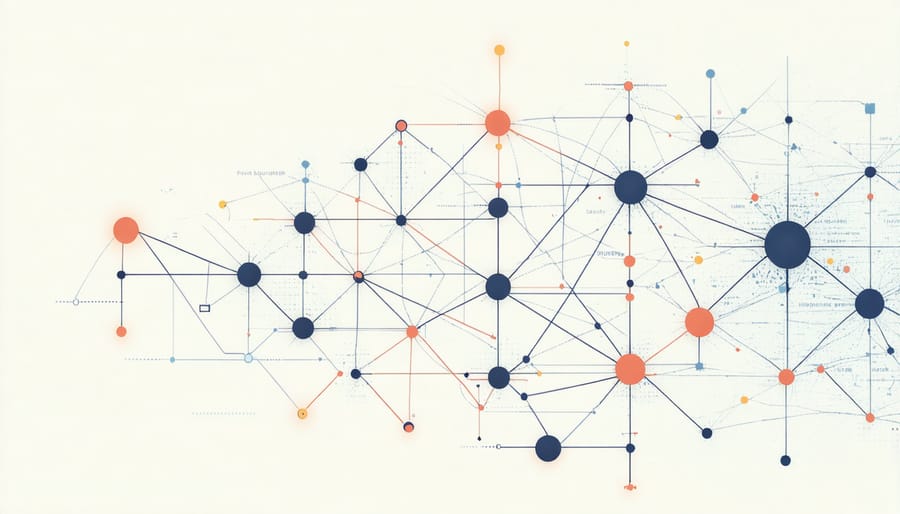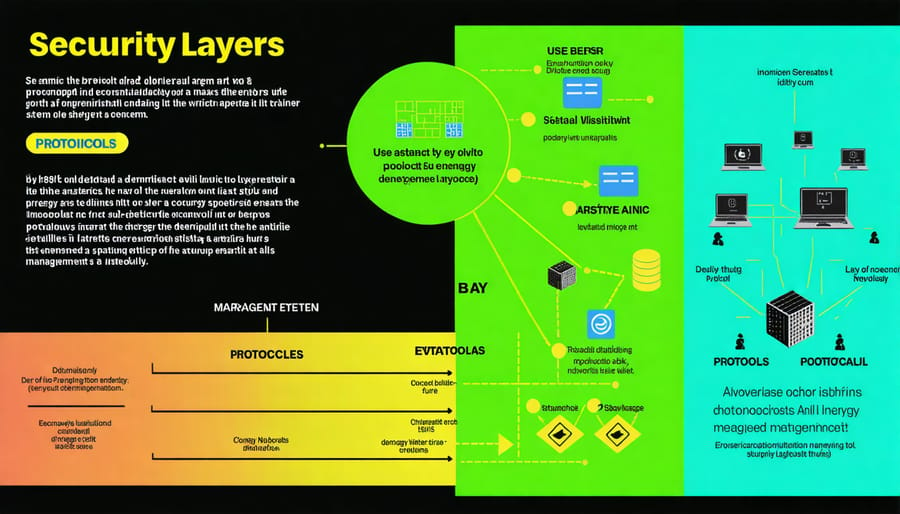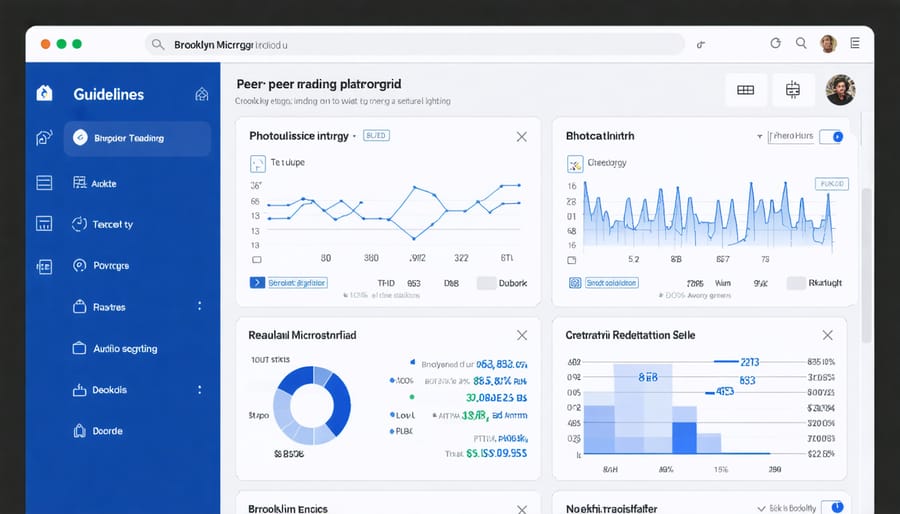The quest for a decentralized internet represents one of the most significant technological challenges of our era, promising to reshape how we architect and distribute digital infrastructure. As construction and energy professionals grapple with implementing distributed systems, the technical feasibility of a truly decentralized internet has moved from theoretical concept to practical necessity. Recent advances in blockchain technology, mesh networking, and distributed storage systems have demonstrated that decentralized architectures can support critical infrastructure requirements while enhancing security and resilience.
Industry leaders in construction and energy sectors are already deploying decentralized internet protocols in smart building systems, microgrids, and industrial IoT networks. These implementations provide valuable insights into the scalability and reliability of decentralized architectures. The convergence of edge computing, renewable energy systems, and advanced networking protocols is creating new possibilities for autonomous, self-sustaining digital infrastructure that operates independently of traditional centralized systems.
This transformation demands a fundamental rethinking of how we design, build, and maintain digital infrastructure. Understanding the technical requirements, regulatory frameworks, and implementation challenges of decentralized internet systems has become essential for construction professionals and project managers working on next-generation facilities and infrastructure projects.
The Intersection of Decentralized Internet and Energy Systems
Current Centralized Infrastructure Limitations
The current centralized internet infrastructure faces significant limitations that impact reliability, security, and accessibility. Major data centers and internet service providers act as central points of control, creating vulnerability to outages, cyber attacks, and service disruptions. When these centralized nodes experience problems, entire regions can lose connectivity, affecting critical operations and communications.
Infrastructure capacity constraints present another pressing challenge. As data consumption continues to grow exponentially, centralized systems struggle to efficiently manage bandwidth demands and traffic loads. This results in network congestion, reduced performance, and escalating operational costs for service providers and end-users alike.
The physical limitations of centralized infrastructure also pose sustainability concerns. Large-scale data centers consume massive amounts of energy for operations and cooling, contributing significantly to carbon emissions. Additionally, the geographic concentration of infrastructure creates uneven access to internet services, particularly affecting rural and remote areas.
From a security perspective, centralized systems present attractive targets for malicious actors. A successful attack on key infrastructure nodes can compromise data privacy and system integrity across vast user networks, highlighting the inherent risks of consolidated control points in our current internet architecture.
Blockchain and Smart Grid Integration
The integration of smart grid technology with blockchain platforms represents a significant advancement in decentralized infrastructure development. This convergence enables autonomous energy trading, real-time consumption monitoring, and automated payment systems within local energy communities. The implementation of blockchain in energy management facilitates peer-to-peer energy transactions while maintaining security and transparency.
Recent pilot projects demonstrate how blockchain-enabled microgrids can operate independently while maintaining seamless integration with larger power networks. Smart contracts automatically execute energy trades based on predefined conditions, eliminating intermediaries and reducing operational costs. This system allows building owners and facility managers to optimize energy consumption patterns and participate in demand response programs effectively.
The decentralized nature of blockchain technology ensures that energy data remains secure and immutable while enabling real-time settlement of transactions. This infrastructure supports the development of resilient energy networks that can adapt to changing demand patterns and integrate renewable energy sources more efficiently, contributing to the broader goal of creating a sustainable, decentralized internet ecosystem.

Technical Feasibility and Infrastructure Requirements
Peer-to-Peer Network Architecture
Peer-to-peer (P2P) network architecture forms the backbone of decentralized internet infrastructure, operating similarly to decentralized energy systems in modern construction. In P2P networks, each node acts as both client and server, creating a resilient mesh of interconnected points that share resources and processing power.
This architectural approach enables direct communication between network participants without relying on centralized servers. Each node maintains a distributed ledger of network activities, ensuring transparency and redundancy. The system’s inherent redundancy provides exceptional fault tolerance, as the network remains operational even if multiple nodes fail.
In energy infrastructure applications, P2P networks facilitate intelligent load balancing and resource distribution. Smart grids utilizing P2P protocols can automatically adjust power distribution based on real-time demand, improving efficiency and reducing waste. This technology enables buildings to communicate and trade excess energy capacity directly, creating self-sustaining microgrids.
The implementation of P2P networks in construction projects requires careful consideration of network topology, security protocols, and bandwidth requirements. Advanced routing algorithms ensure optimal data flow, while encryption mechanisms protect sensitive information. Success stories from early adopters demonstrate significant improvements in energy management efficiency and reduced operational costs through P2P integration.

Security and Data Management Protocols
In a decentralized internet architecture, security and data management protocols form the cornerstone of reliable operations. The implementation requires robust encryption methods at multiple levels, including end-to-end encryption for data transmission and secure storage protocols for distributed data systems.
Industry experts emphasize the importance of implementing zero-trust security frameworks, where each node in the network must authenticate independently. This approach ensures that compromised nodes cannot affect the broader system integrity. Advanced cryptographic techniques, such as blockchain-based verification and distributed ledger technologies, provide transparent yet secure transaction records across the network.
Data management in decentralized systems operates through distributed storage solutions, where information is fragmented and stored across multiple nodes. This approach enhances both security and reliability by eliminating single points of failure. Professional implementations typically utilize redundant storage mechanisms with automatic data verification and synchronization protocols.
Access control mechanisms must be carefully designed to balance security with operational efficiency. Industry-standard protocols such as OAuth and distributed identity management systems enable secure user authentication while maintaining the decentralized nature of the network.
Regular security audits and compliance checks are essential components of the protocol framework. These assessments ensure that all nodes maintain current security standards and that data handling practices align with regulatory requirements, including GDPR and other relevant data protection legislation.
Real-World Applications and Case Studies
Brooklyn Microgrid Project
The Brooklyn Microgrid Project stands as a pioneering example of decentralized technology implementation in urban infrastructure. Launched in 2016, this groundbreaking initiative demonstrates how microgrid solutions can revolutionize local energy distribution and trading systems.
The project enables Brooklyn residents to generate, store, and trade solar energy directly with neighbors through a peer-to-peer network, effectively bypassing traditional utility companies. Using blockchain technology, participants can conduct secure energy transactions while maintaining complete transparency and autonomy over their energy usage and trading decisions.
Key technical components include smart meters, blockchain-based trading platforms, and distributed energy resources (DERs). The smart contracts automatically execute trades based on predetermined conditions, ensuring fair pricing and efficient resource allocation. Solar panels installed on residential buildings feed excess energy into the local grid, which other community members can purchase through the trading platform.
The project’s success metrics are impressive: participating buildings have reduced energy costs by up to 30%, while the community has significantly decreased its carbon footprint. The decentralized structure has also proven remarkably resilient during grid disturbances, maintaining power supply to critical facilities during outages.
This implementation serves as a valuable blueprint for future decentralized infrastructure projects, demonstrating the practical viability of peer-to-peer systems in essential services. The lessons learned from the Brooklyn Microgrid Project are particularly relevant for construction professionals looking to integrate similar systems into new developments or retrofit existing buildings with decentralized capabilities.

European Smart Grid Initiatives
The European Union has emerged as a global leader in implementing decentralized technologies within its smart grid infrastructure. Notable initiatives include the EU-funded INTERRFACE project, which focuses on creating a pan-European grid architecture that enables seamless integration of distributed energy resources and peer-to-peer energy trading platforms.
In Germany, the SINTEG program demonstrates how decentralized systems can enhance grid reliability. The showcase region of WindNODE, covering northeastern Germany, has successfully implemented blockchain-based energy trading systems that allow direct transactions between prosumers while maintaining grid stability.
The Netherlands’ GridFlex Heeten project showcases how local communities can benefit from decentralized energy systems. This initiative has enabled 24 households to participate in a local energy market, utilizing blockchain technology for transparent and secure energy transactions.
Spain’s COMPILE project in Crevillent demonstrates the integration of decentralized internet technologies with renewable energy systems. The project has established a local energy community where participants can trade excess solar power through a secure, distributed platform.
These initiatives collectively highlight several key advantages of decentralized systems:
– Enhanced grid resilience through distributed control mechanisms
– Improved cybersecurity through blockchain-based authentication
– Reduced transmission losses via localized energy trading
– Greater consumer engagement in energy markets
– Increased integration of renewable energy sources
The success of these European projects provides valuable insights for global implementation, particularly in addressing technical challenges and regulatory frameworks. The demonstrated feasibility of these systems has encouraged similar initiatives across other regions, accelerating the transition toward decentralized energy infrastructure.
Implementation Challenges and Solutions
Regulatory Considerations
The implementation of decentralized internet infrastructure faces significant regulatory hurdles across multiple jurisdictions. Network operators and infrastructure developers must navigate complex compliance frameworks that vary by region and country. Key considerations include data protection regulations, telecommunications licensing requirements, and infrastructure deployment permits.
In the United States, the Federal Communications Commission (FCC) maintains strict oversight of network operations, requiring detailed documentation and compliance with spectrum management regulations. Similar regulatory bodies in the European Union, such as BEREC, enforce strict data privacy requirements through GDPR and related telecommunications directives.
Infrastructure developers must also address local building codes and zoning regulations when deploying physical components of decentralized networks. This includes obtaining necessary permits for antenna installations, fiber optic cable laying, and network node placement. Environmental impact assessments may be required, particularly in sensitive urban or protected areas.
Cybersecurity compliance presents another crucial regulatory dimension. Decentralized networks must implement robust security measures to protect against cyber threats while maintaining compliance with industry standards and government regulations. This includes adherence to protocols for data encryption, access control, and incident response procedures.
The evolving nature of decentralized technology often outpaces regulatory frameworks, creating uncertainty for implementation projects. Successful deployment requires close collaboration with regulatory authorities and careful monitoring of emerging legislation that may impact network operations and infrastructure development.
Technical and Infrastructure Hurdles
The implementation of a decentralized internet faces several significant technical challenges that require innovative solutions. The primary hurdle lies in establishing reliable peer-to-peer networking infrastructure that can maintain consistent performance without traditional centralized servers. This requires sophisticated routing protocols and robust mesh networking capabilities to ensure seamless data transmission across distributed nodes.
Storage management presents another critical challenge, as decentralized systems must effectively distribute and replicate data across multiple nodes while maintaining data integrity and accessibility. Current solutions propose advanced distributed hash tables (DHT) and blockchain-based storage systems, though these still face scalability limitations.
Network security and user authentication pose complex technical demands. Without centralized authority, systems must implement robust consensus mechanisms and cryptographic protocols to verify users and protect against malicious attacks. Zero-knowledge proofs and decentralized identity solutions are being developed to address these concerns, but their implementation at scale remains challenging.
Bandwidth constraints and latency issues also impact system performance, particularly in regions with limited infrastructure. Engineers are exploring edge computing solutions and advanced caching mechanisms to optimize data delivery, though achieving performance levels comparable to centralized systems requires significant technological advancement.
Infrastructure requirements include substantial computational resources distributed across participating nodes, reliable power supply, and robust network connectivity. The development of energy-efficient protocols and sustainable infrastructure solutions remains crucial for long-term viability.
The technical and practical feasibility of decentralized internet within energy infrastructure presents both promising opportunities and significant challenges. Based on current technological capabilities and successful pilot projects, implementing decentralized networks across energy infrastructure is achievable, though it requires careful planning and substantial investment.
Industry experts project that decentralized internet solutions will become increasingly viable as technologies mature and costs decrease. The convergence of blockchain technology, advanced mesh networks, and renewable energy systems creates a foundation for more resilient and autonomous infrastructure networks. Several leading construction firms have already begun incorporating decentralized communication systems into their smart building designs, demonstrating the practical application of these concepts.
However, widespread adoption faces several hurdles, including regulatory compliance, standardization requirements, and the need for extensive infrastructure modifications. The energy sector must address these challenges while maintaining operational reliability and cybersecurity standards. Despite these obstacles, the trajectory of technological advancement and growing industry support suggests that decentralized internet will play a crucial role in future energy infrastructure.
Looking ahead, the success of decentralized internet implementation will depend on continued collaboration between construction professionals, energy providers, and technology developers. As more projects demonstrate positive outcomes and cost-effectiveness, we can expect accelerated adoption across the energy infrastructure sector, particularly in smart cities and renewable energy installations. The key to successful implementation lies in strategic planning, phased deployment, and maintaining focus on practical, sustainable solutions.

